Few WordPress features offer more return on your learning investment than block patterns.
WORDPRESS
15 Best Animated WordPress Themes To Impress Your Visitors in 2023

Let’s admit it: Everyone wants their website to have that ‘wow’ factor. One way to accomplish this is with smooth animation that make it come to life! And that’s why Animated WordPress themes are where it’s at!
But when you’re running WordPress, choosing a good animated theme comes with its own problems, like loading speeds, compatibility with plugins, and design limitations.
Luckily, we’ve compiled a list of the best 15 animated WordPress themes so you can create your dream store, blog, or portfolio today.
Let’s dive in:
1. Divi
Being one of the most popular WordPress themes on the planet, Divi is our top choice for building intuitive, responsive, and visually-appealing websites. Its drag-and-drop builder is simple enough to be used by a second-grader and allows you to view changes in real-time.
Divi is also loaded with a range of highly-customizable animations that transform as you scroll and interact with them. You can build each webpage from scratch using its 200+ elements or choose from 2,000+ pre-made website designs and edit your way to perfection.
The theme is also fully search-engine-optimized and fine-tuned by Divi to load up within seconds.
2. Impreza
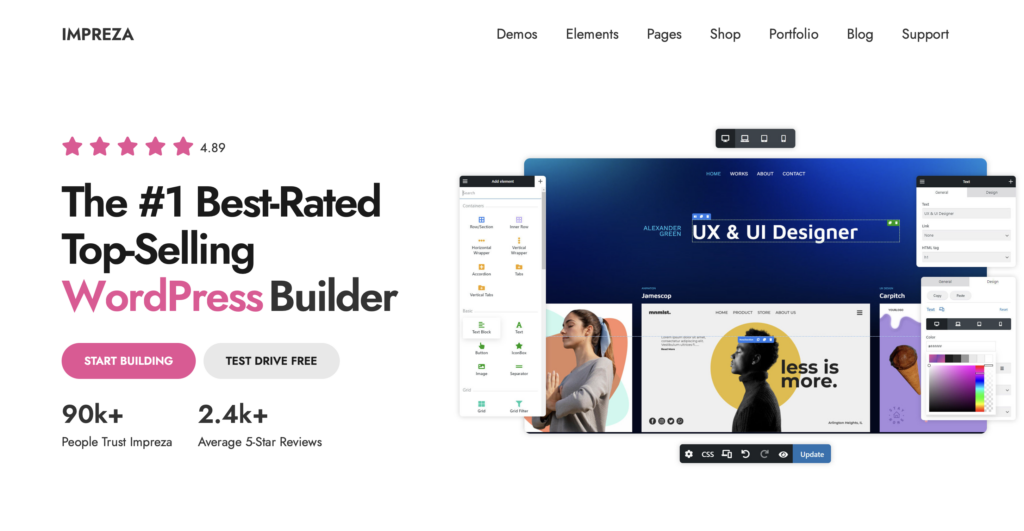
Impreza is our top pick for online businesses that want to stun their customers with brilliant visuals and buttery animation effects. It’s used by 90,000+ websites and has 50+ demos for e-commerce stores, freelancers, and blog owners. Like any great WordPress theme, Impreza also uses a drag-and-drop builder called ‘Visual Composer’ for effortless real-time design.
And that’s not all. The multi-purpose theme also comes with a library of 100+ elements to build an interactive site full of features. Niche site owners will also be pleased to hear that the theme is full of SEO options, including built-in meta tag editors and support for Yoast SEO. Impreza is the highest-rated theme on ThemeForest and is sometimes recognized for having the strongest page builder in the business.
3. Jupiter
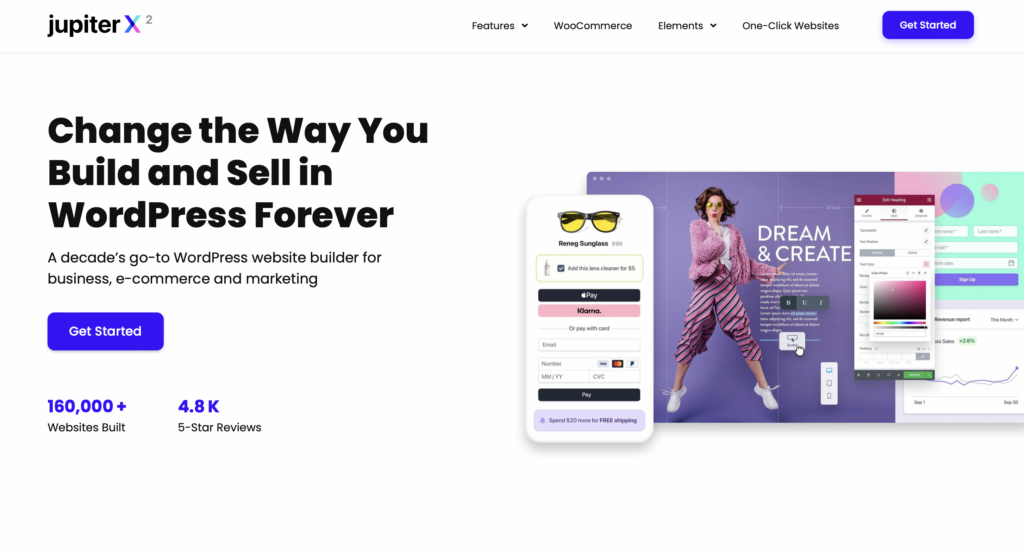
Jupiter is one of the best alternatives to Shopify and all-around themes for creating aesthetic yet powerful e-commerce stores. You can build your dream website from scratch using their exclusive Layout Builder or choose from 450+ ready-to-publish templates to kickstart your business.
One of the best features of Jupiter is its sales-funnel builder — an intelligent tool that allows you to design a lucrative purchase process and boost conversions.
You can also add a variation selector, create pop-ups, and send ‘out-of-stock’ notices within the theme — features typically missing from free WordPress themes. Jupiter is trusted by 160,000+ customers and is a worthy investment for online retailers and dropshippers.
4. Ultra Theme

The first multi-purpose WordPress theme on our list — Ultra from Themify can convert any blank webpage into a piece of art. You can create mesmerizing portfolios, e-commerce stores, magazines, or agency sites by choosing one of their 30+ pre-built demo sites.
Or, if you want more design independence, you can use the Live Page Builder to tweak each element to your preference.
Ultra also comes with 12+ bonus add-ons with captivating animation. This includes a slider, typewriter, price table, counter, and image grid — all of which come to life with user interaction.
Additionally, the powerful page builder also allows you to add a silky-smooth parallax effect and even animate colors. Above all, Ultra is fully search-engine-optimized, is compatible with WPML, and seamlessly integrates with WooCommerce so you can design your dream website.
5. Movedo

Movedo is a game-changer for people that love animations and smooth parallax effects. This multi-purpose theme is crafted for a fully-immersive experience and comes with 17+ pre-built website templates. You can personalize your pages using Visual Composer drag-and-drop builder and integrate beautiful banners using Revolution slider.
One of Movedo’s best features is their Ultra-Dynamic Parallax scrolling that moves with the motion of your cursor. It also comes with various clipping animations, hover effects, and a ‘safe button’ that flows down to reveal an additional menu. Even with so many animations, Movedo offers full search engine optimization, translation readiness, lightning-fast loading speeds, and lifetime updates for customers.
6. Parallax

Parallax by Themify is all about fluid animations and elegant web pages. It’s a lightweight WordPress theme that comes with super-smooth parallax functionality, gorgeous sliders, and even animated progress bars. You can select from 60+ pre-designed layouts and customize the theme using an intuitive drag-and-drop builder.
Additionally, the theme comes with 11+ cool header layouts and an option for setting custom background images to make your website truly unique. All the images/graphics will be super-crisp and adapt to different devices while retaining your website’s appearance. While Parallax certainly lacks features, it’s the perfect animated theme for website owners with simple websites or building dynamic single webpages.
7. Zephyr
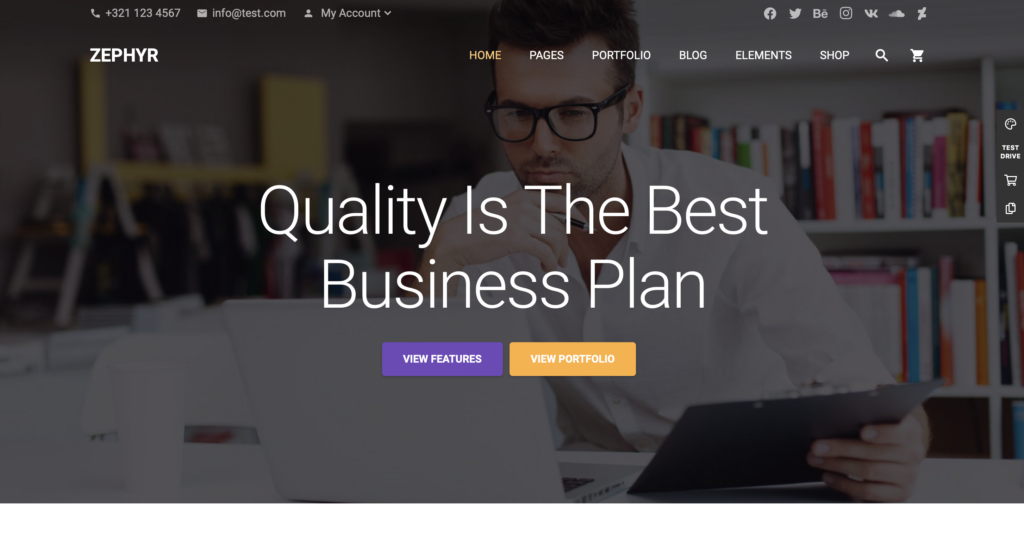
Zephyr is a highly-underrated gem on the ThemeForest marketplace that’s perfect for building dynamic blogs and business sites. It’s loaded with hundreds of customization options — 6 blog layouts, 1300+ icons, and 657 fonts, being just a few of them. Each element can be easily adjusted using their built-in Visual Composer — a drag-and-drop tool worth $34 on its own.
But animations are where the Zephyr theme really shines. You can add smooth parallax scrolling, hover effects, and eye-catching slides using Slider Revolution (also worth $19).
On top of that, Zephyr is coded with SEO in mind and optimized for WPML to support multiple languages. It loads up super-fast and is fully responsive, with support for ultra-sharp retina graphics.
8. Newspaper
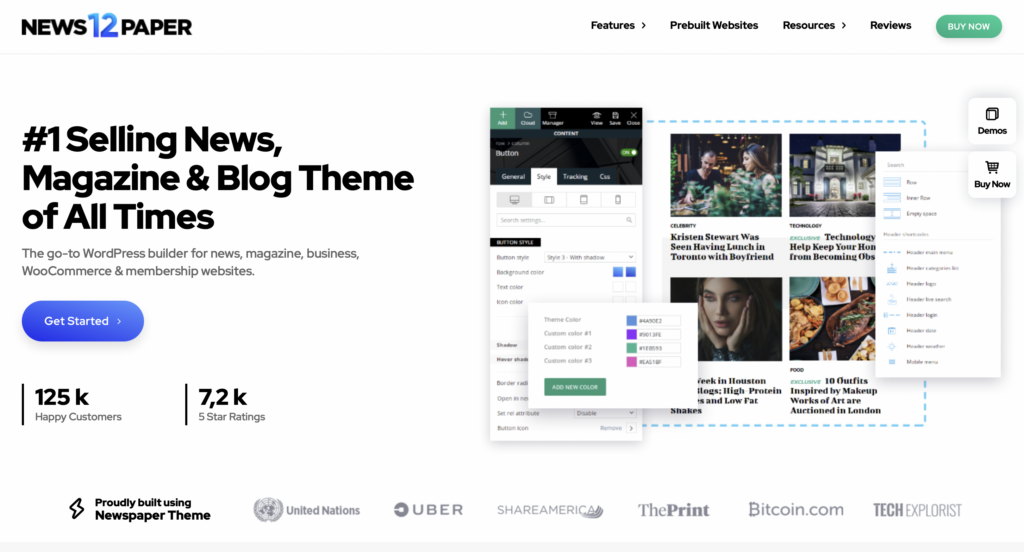
Every magazine and online publication knows the value of a beautiful front page, quick loading speeds, and subscription revenue. Newspaper is a best-selling WordPress theme loaded with features trusted by brands like Uber, Bitcoin, and United Nations. It comes with 150+ pre-built designs and a huge library of animated templates that makes websites come to life!
Newspaper also includes smart pop-ups — a feature that lets you place ads, offers, and subscription prompts without disturbing visitors. The Opt-in Builder lets you create compelling paywalls and increase memberships. You get an intuitive contact form builder in the back end to streamline the customer database and user-review system to boost your credibility.
9. Helion

One of the most revered creative portfolio themes for WordPress — Helion is an easy recommendation for artists, photographers, and design professionals. It runs on the Elementor page builder and has a collection of built-in modern layouts. Helion also comes with some of the most impressive 20+ animations we’ve ever seen in a theme.
Additionally, it allows extensive color customization to make your site truly unique. The theme is also loaded with hundreds of fonts, shortcodes, and over 750 other personalization options.
Helion is fully-responsive and supports retina images, and is WooCommerce-ready, so you can monetize your artwork whenever you like!
10. Remake

When it comes to building minimalistic sites with smooth animations, Remake by Codeless takes the win. You can choose from their 10+ pre-made skins to kickstart your agency or use Elementor to drag-and-drop your favorite elements in real time. It also produces some of the best parallax effects and hover animations, making your portfolios look awesome.
Despite using heavy animated effects, Remake has blazing-fast loading speeds and is highly responsive to different devices. It offers a sleek and modern layout and seamlessly integrates with social media accounts — an essential feature for budding artists/freelancers. All of this comes with free lifetime support from Codeless and compatibility with popular WordPress plugins.
11. The Gem

Loaded with over 400 beautiful pre-built templates — The Gem has a little something for everyone. This multi-purpose theme has a demo site for photographers, agencies, online stores, magazines, cryptocurrencies, and just about any business you can think of. It’s also super-quick, highly responsive, and fully optimized for search engines.
But that’s not all. The Gem comes with WPBakery and Elementor page builder for free, so you can conveniently tweak each element of your website.
You can also add ultra-smooth parallax effects and CSS3 animations to enhance user experience. The Gem is also compatible with many mainstream plugins and is translation-ready, so you can take your website global!
12. Ohio

Impress your clients with highly-aesthetic agency and personal portfolios using Ohio theme. This animated WordPress theme comes with 39+ layouts and hundreds of customization options — all powered by Elementor and WPBakery.
You can quickly create responsive portfolios using Ohio’s vast demo library or personalize everything down to the fonts and colors (there are more than 13,000 of them!)
Whatever you design, the theme’s flawless coding will consistently load your site within seconds. You can also integrate fluid CSS3 animations with all of their 326+ elements to make the site more interactive. Agencies can introduce products using WooCommerce plugin or create beautiful blog sections with 190+ pre-made pages — all of which are included in the package.
13. FlatSome

Flatsome is the #1 best-selling WooCommerce theme on the market. And over 200,000 customers seem to agree. It’s the ideal theme for building your dream online store — featuring a proprietary drag-and-drop tool, rapid loading speeds, and free lifetime updates. It also comes with tons of cool animations, including parallax scrolling, hover effects, and more.
But that’s not all. Flatsome has also partnered with Cloudways Hosting, so your visitors never have to suffer delays. Moreover, the animated theme offers in-depth customization of checkout pages, fonts, menus, and product pages. It’s also fully responsive and optimized for the best mobile shopping experience.
14. Amos

Amos is a complete package for agencies/freelancers that want to build highly-responsive animated portfolios. You can create a full-scale website within hours using the theme’s 28+ homepage designs and 60+ essential page layouts. It also has drag-and-drop functionality via Visual Composer, mega menu templates, and the ability to add fluid CSS3 animations to make your websites interactive and dynamic.
Moreover, Amos is fully compatible with WPML so that you can reach out to foreign clients. MailChimp and Contact Form 7 are also included for free to make email marketing easier for agencies. Plus, the animated WordPress theme rocks super-fast loading speeds and is fully responsive to tablets and smartphones for convenient browsing.
15. Hello
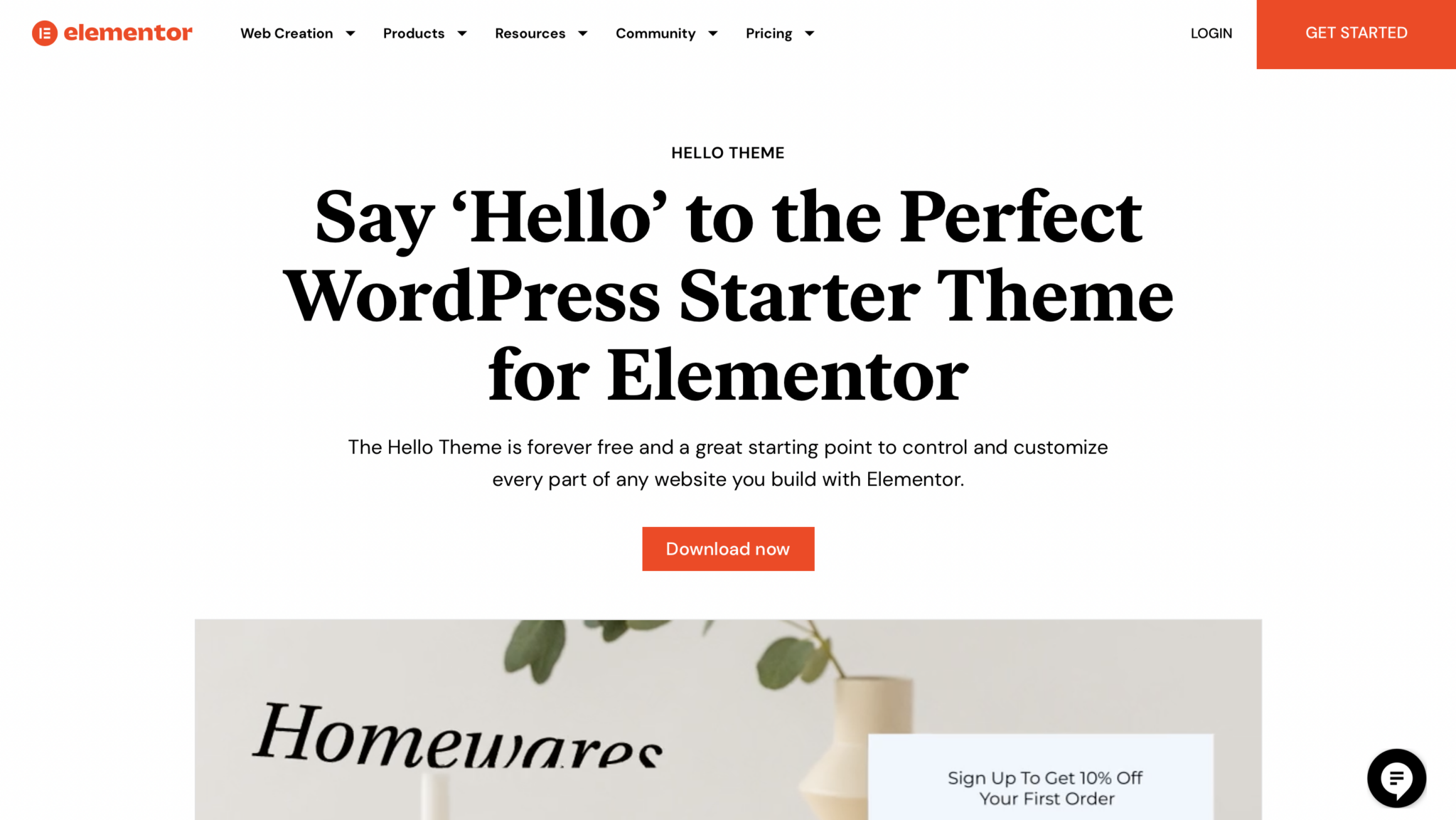
Hello is a lightweight, responsive, animated WordPress theme for people who love designing sites with Elementor. It occupies just 6kb of space and acts as the perfect blank slate for Elementor’s drag-and-drop builder and its 100+ widgets. The theme itself is fully optimized for search engines and seamlessly adapts to mobile phones and tablets.
The animated theme costs $0 and offers over 100 website kits for freelancers, blog owners, and even e-commerce stores. Once coupled with Elementor (pro works even better), you can fine-tune its widgets with various fonts, color palettes, and cool animation effects without overburdening your servers.
And if you ever run into technical troubles, you can always retreat to Elementor’s supportive community to solve your queries.
How To Choose The Best Animated WordPress Theme
Choosing the best WordPress animated theme for your website can be challenging. You must impress your visitors with a beautiful design while prioritizing both performance and accessibility.
When you’re hunting for your next animated theme, consider the following factors to make a better decision:
- Simple and Minimalistic Design
- Fast Loading Speeds
- Flexible Customization Options
- Responsiveness and Mobile Compatibility
- Support For Plugins
- Optimized for Search Engines
- Frequent or Lifetime Updates
- Compatibility For Different Browsers
- Good Customer Support Team
Conclusion
Adorning your WordPress website with parallax effects and animations can significantly improve session times and leave a lasting impression on potential customers.
If you want a sleeker and cleaner look for your website, check out our list of 31 Best Minimalistic WordPress Themes.
Or, if you’re starting out a niche website and want to maximize traffic and SERP rankings, look at our list of 31 Best SEO Friendly WordPress Themes.
WORDPRESS
WordPress Block Patterns Give You Superpowers – WordPress.com News
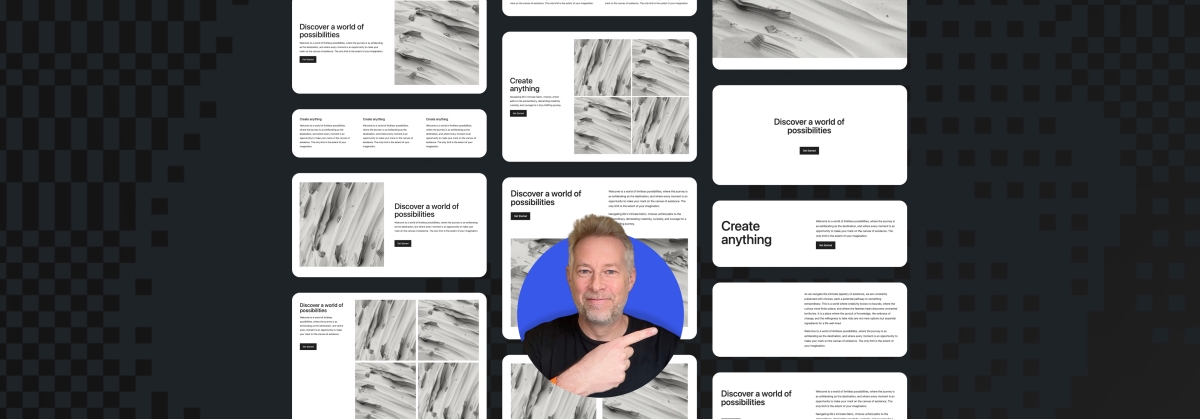
With the power of block patterns you’ll be a WordPress superstar in no time, whether you’re an establish pro or just starting out. Block patterns are professionally designed layouts that you can add your site in a single click. What makes them especially powerful is that once they’re inserted, you can edit and customize every aspect. (Or, you can leave them be!)
In today’s Build and Beyond video, Jamie Marsland walks you through everything you need to go to become a block pattern expert, in under four minutes.
Get started on your site today with a free trial:
Join 110.2M other subscribers
WORDPRESS
Astra Theme Coupon 2024 (Apr) [40% Discount, Save $400]
![Astra Theme Coupon 2024 (Apr) [40% Discount, Save $400] Astra Pricing Plans on discounts](https://articles.entireweb.com/wp-content/uploads/2024/04/1713797772_611_Astra-Theme-Coupon-2024-Apr-40-Discount-Save-400.png)
Do you want higher discount on kartra?? We are excited to announce that our Astra Theme Coupon Codes are now available!
Astra is a well-liked, multifunctional WordPress theme that is frequently used by bloggers, companies, and online shops among the other themes.
It is a thin, quick, adaptable, and somewhat pricey theme that offers customers a simple base on which to create their websites.
So if you are thinking about buying astra theme, This article will be a gold mine for you.
In this article, we are sharing every single detail related to Astra Theme Coupon, So you can get the maximum discount on their plan.
Astra Offers Summary:
Total Coupons
7 Offers
Maximum Discount
Up to 50% OFF
Maximum Saving
Up to $400
Astra Plans For Offer
Annual and Lifetime
Money-Back Guarantee Offer
14 Days
New Offers on Astra-
Lastest Astra Theme Coupons
Best for Individual Site or Bloggers.
Astra Pro Coupon – For Lifetime Plan Value for Money
Get All Astra Pro Features with 100+ Templates and Unlimited Sites License. This One-time Investment can save you hundreds of dollars later.
Best for Individual Site or Bloggers, Business Site. (Most Selected)
Best Plan for Freelancers and New Web Designers.
Best Plan for Freelancers and New Web Designers. (Our Recommendation for Business)
Best Plan for Agencies and StartUps.
Best Plan for Agencies and StartUps.
Astra New Year 2024 Sale
Astra is celebrating 1 Million Installations and Offering up to 63% Off on their Plans. (Default offer from the WP Astra)
Save Big with Astra Special Sale on Every Plan. [Maximum Saving]
Note: Some coupon codes may have restrictions and are only valid for specific packages.
Easy Steps To Follow-
How To Use Coupon To Get Astra Discount
Here are some simple steps that you can follow and get discount on any Astra theme plans:
Step 1: Choose the Astra Theme package that you wish to purchase. There are three options available: Astra Pro, Essential Bundle, and Growth Bundle.
![Astra Theme Coupon 2024 (Apr) [40% Discount, Save $400] Astra Pricing Plans on discounts](https://articles.entireweb.com/wp-content/uploads/2024/04/1713797772_611_Astra-Theme-Coupon-2024-Apr-40-Discount-Save-400.png)
Step 2: Add the desired package to your cart and proceed to checkout.
Step 3: On the checkout page, you will find a coupon code box where you can enter the coupon code.
Step 4: Enter the coupon code in the designated field and click on the “Apply Coupon” button.
![Astra Theme Coupon 2024 (Apr) [40% Discount, Save $400] Astra Theme Coupon Code on checkout](https://articles.entireweb.com/wp-content/uploads/2024/04/1713797773_676_Astra-Theme-Coupon-2024-Apr-40-Discount-Save-400.png)
Step 5: Once the coupon code is applied, you will see the discount reflected in the final price.
Step 6: Complete the payment process and make the purchase.
It’s that simple! By using the Astra Promo Code, you can save a considerable amount on your purchase of the Astra Theme. Make sure to use the coupon code before it expires to take advantage of the discount.
Choose The Best Plan For You-
Astra Theme Plans With Discount
Here we are sharing all the details of astra theme plans, so you can choose the best plan for you and get dicount:
Astra Pro offers hundreds of customization options to simplify and accelerate the process of creating your desired website. Normally priced at:-
- $59 per year or
- $299 for a lifetime,
But you can take advantage of our Astra theme coupon Codes and save $12 annually or $72 for a lifetime purchase by getting Astra Pro for $47 per year or $227 for a lifetime.
With Astra Pro, you will have access to numerous features that will elevate your website to new heights. These include:-
- Advance Header Builder,
- Advance Blog Layouts,
- Sticky Header,
- Custom Layouts & Hooks,
- Advance Typography,
- Advanced Colors Options,
- Mega Menu,
- Global Color Palettes,
- Advance Footer Builder,
- WooCommerce Controls,
- Native AMP Support,
- White Label,
- Product Updates,
- Premium Support,
- Unlimited Website Usage,
- Extensive Training,
- Risk-Free Guarantee.
The Essential Bundle from Astra Theme offers a complete solution for building exceptional websites. This Bundle comes with premium website templates and addons to enhance your preferred page builder.
Essential Bundle have two payment option:
- a one-time payment of $677.
- an annual payment of $137.
But you can take advantage of our Astra Coupon Code and save $32 annually or $172 for a lifetime purchase.
With the Essential Bundle, you will have access to all the necessary tools to create stunning and functional websites that stand out from the competition, including:-
- Astra Pro (i.e. all features of Astra Pro),
- 180+ Premium Starter Templates,
- WP Portfolio Plugin,
- Choice of One Page Builder Addon,
- Ultimate Addons for Elementor OR Ultimate Addons for Beaver Builder,
- Product Updates,
- Premium Support,
- Unlimited Website Usage,
- Extensive Training,
- Risk-Free Guarantee.
The Growth Bundle from Astra Theme is the most sought-after choice among users, providing a complete set of tools required to establish and expand your online business.
Growth Bundle have two payment option:
- An annual payment of $187
- A one-time payment of $937
But you can take advantage of our Astra Discount Code and save $62 annually or $7312 for a lifetime purchase.
The Growth Bundle grants access to everything you need to take your business to the next level, including:-
- Everything in Essential Bundle, and
- Convert Pro Plugin,
- Schema Pro Plugin,
- Ultimate Addons for Beaver Builder,
- Ultimate Addons for Elementor,
- Spectra Pro (Coming Soon),
- SkillJet Academy Membership,
- Our Future Products,
- Product Updates,
- Premium Support,
- Unlimited Website Usage,
- Extensive Training,
- Risk-Free Guarantee.
Points To Keep in Mind-
Astra Terms and Policy For Coupons
This section refers to the terms and conditions associated with the use of coupons offered by Astra Theme. so here are some points that you should keep in mind while applying coupon on Astra plans:
- Coupon Validity: Coupons may have a specific expiration date and can only be redeemed within that time frame.
- Eligibility: Some coupons may only be available to new customers or certain users, while others may be available to everyone.
- Coupon Usage: Coupons may only be used once per customer and may not be combined with any other offers or discounts.
- Discount Amount: Coupons may provide a fixed dollar amount off the purchase price or a percentage off.
- Product Restrictions: Some coupons might only be usable for a particular product or set of products.
- Payment Method: Some coupons might only be redeemed with specific payment options, like PayPal or a credit card.
- Terms and Conditions: Coupons are subject to Astra Theme’s terms and conditions, which include but are not limited to its refund policy and privacy policy.
- Changes and Updates: Astra Theme reserves the right to modify or discontinue coupons at any time without prior notice.
Our Opinion-
Conclusion- WP Astra Theme Coupon 2024
Astra is a robust and adaptable WordPress theme that is ideal for online stores, enterprises, and bloggers. It is the best option for anyone wishing to create a website that looks professional thanks to its responsive design, user-friendly interface, and vast selection of pre-designed themes.
Users can build up an online store quickly and easily with the help of the rich customization options and WooCommerce connection available in the Astra Pro version.
An excellent option for anyone wishing to develop a website, Astra’s many plans offer a solution for various demands and budgets.
With our Astra theme discount code, you’ll be able to build a beautiful, fast, and user-friendly website that meets all of your needs without breaking the bank. Don’t miss out on this opportunity to take advantage of our Astra discount and create the website of your dreams.
Frequently Asked Question
Quries Related To Astra Coupon
How can I use the Astra discount code?
The Astra Coupon Code is a unique promotional code that Astra Theme provides to its clients. Simply enter the code in the corresponding field during checkout when ordering Astra Pro or Growth Bundle to use it. Your total will be adjusted automatically to reflect the savings.
How frequently are new Astra promo codes released?
Astra discount codes are frequently provided during special sales and occasions, such holidays or the introduction of new products. The Astra website should always be checked, though, for the most recent deals and discounts.
How much discount will I get with the Astra Coupon Code?
The amount of discount you receive with an discount code varies depending on the offer. You can expect to save anywhere from 10% to 50% off the regular price of Astra Pro or Growth Bundle.
Can I use the Astra theme discount Code on renewals or upgrades?
Yes, the Astra discount code can be used for both renewals and upgrades of Astra Pro or Growth Bundle.
How many coupons I can use on single purchase?
On Astra Theme, you can apply only one coupon on single purchase, and you can apply your next coupon on another purchse
Does Astra Provide any Lifetime offer?
Yes, Astra provide lifetime offer on both Pro and bundle plan, so you can make one time payment and enjoy lifetime.
Does Astra Offeres any student discount?
No, astra does not offer any student discount, as a student you can use our astra coupon and get discount on any plan you want.
WORDPRESS
Elementor Pro Discount (Apr 2024) [70% OFF, Save $150]
![Elementor Pro Discount (Apr 2024) [70% OFF, Save $150] Elementor Coupon](https://articles.entireweb.com/wp-content/uploads/2024/04/1713729377_Elementor-Pro-Discount-Apr-2024-70-OFF-Save-150.png)
Looking For the highest discount on Elementor Pro?? We have the latest and most active Elementor coupon, so you can buy Elementor at a discounted price.
If you are someone who wants to buy a plugin that helps you to create a website as easily as possible then we can say, nothing better than Elementor.
In this article, we are sharing all the details that will help you to get a discount on Elementor.
So you can buy this tool at a discounted price.
Elementor Offers Summary:
| Total Coupons | 14 Offers |
| Max Discount | 70% Discount |
| New Offer Price | $59/month |
| Total Saving | Up to $200 |
| Money-back Guarantee Offers | Yes |
Latest & Active Offers-
Elementor Coupons 2024
Elementor Pro Plugin
$59-$399
Get Elementor Pro Plugins at the Best Price.
Elementor PRO Plans have a Flat Price, It offers Discounts and Deals only on Some Occasion.
$
Elementor Page Builder Plugin Coupons:
Get a Discount on Elementor Personal Plan to Create Amazing Pages/Posts on 1 Website with 50+ Pro Widgets + 300+ Pro Templates with support & update. (10+ Website Kits)
Best for Individual Blogger and Business Sites.
Get a Discount on Elementor Personal Plan to Create Amazing Pages/Post on 3 Websites with 50+ Pro Widgets + 300+ Pro Templates with support & update. (10+ Website Kits)
Best for bloggers who own 1+ sites and bloggers.
Get a Discount on Elementor Personal Plan to Create Amazing Pages/Post on 25 Websites with 50+ Pro Widgets + 300+ Pro Templates with support & updates. (10+ Website Kits)
Best for Web Designers and Freelancers.
Get a Discount on Elementor Agency Plan to Create Amazing Pages/Posts on 1,000 Websites with All PRO Features & VIP Support. (New 10+ Website Kits)
Best for Developers, Web Agencies, and Freelancers with Client Management.
Elementor Hosting Plans Coupons:
Website: 1
Storage: 10 GB
Monthly Visits: 25,000
Bandwidth: 30GB/mo
New Plan from Elementor, Host Elementor Website with Elementor.
Website: 1
Storage: 20 GB
Monthly Visits: 50,000
Bandwidth: 50GB/mo
New Plan from Elementor, Host Elementor Website with Elementor.
Website: 3
Storage: 25 GB
Monthly Visits: 5,000
Bandwidth: 75GB/mo
New Plan from Elementor, Host Elementor Website with Elementor.
Website: 10
Storage: 40 GB
Monthly Visits: 100,000
Bandwidth: 100GB/mo
New Plan from Elementor, Host Elementor Website with Elementor.
Host your 1 Website with Elementor Hosting Solution and Get Elementor Pro Plugin also. Elementor hosting has all the essential features for your optimized website.
New Plan from Elementor, Host Elementor Website with Elementor.
Elementor Non-Profit Discount
Elementor Pro offers the same pricing plans for everyone, Non-profits or organizations can avail of its regular offers and discounts.
Easy Steps To Follow-
How To Apply Coupon And Get Discount
After getting some of the best coupons from the above coupon list, it is also important to learn how to use these coupons and get a discount on your favorite plan.
So in this section, you mentioned some steps that you can follow, and get a discount on Elementor plans.
Step1. Visit To Official Website:
Start by visiting the official Elementor website and go to their pricing section.
Step2. Choose Your Plan:
Select the Elementor plan you want to purchase. Elementor offers both a free version and paid plans with additional features and support. Choose the plan that aligns with your requirements.
![Elementor Pro Discount (Apr 2024) [70% OFF, Save $150] Elementor Plugin Pricing For Coupon](https://articles.entireweb.com/wp-content/uploads/2024/04/1713729367_34_Elementor-Pro-Discount-Apr-2024-70-OFF-Save-150.png)
After selecting your desired plan, click on the “Buy Now” button to proceed to the checkout page.
Step4. Add Your Coupon:
On the checkout page, you’ll find a field labeled “Enter code”, Enter the coupon code you have in this field.
![Elementor Pro Discount (Apr 2024) [70% OFF, Save $150] Applying Coupon on elementor checkout page](https://articles.entireweb.com/wp-content/uploads/2024/04/1713729367_937_Elementor-Pro-Discount-Apr-2024-70-OFF-Save-150.png)
After entering the coupon code, click on the “Apply” button next to the coupon code box. The discount associated with the coupon code will be applied to your total purchase price.
Step6. Review Your Order Summary:
Review your order summary to ensure the discount has been applied correctly. Once you’re satisfied, proceed to enter your payment details and complete the purchase.
You are done!!
Choose The Best Plan-
Elementor Plans For Coupon
![Elementor Pro Discount (Apr 2024) [70% OFF, Save $150] Elementor plans for coupons](https://articles.entireweb.com/wp-content/uploads/2024/04/1713729368_26_Elementor-Pro-Discount-Apr-2024-70-OFF-Save-150.png)
Here we are sharing some best plans for you, Elementor Pro offers a range of plans designed to cater to various needs, from basic website creation to managing a large number of sites for agencies.
The Essential plan is the entry-level option, which is ideal for individuals looking to build a single basic website. It includes access to 50 Pro Widgets, Theme Builder, Dynamic Content, Form Builder, Popup Builder, and more.
Premium support is also part of the package, ensuring users can get help when they need it. this plan will cost you $59 per year
The Advanced plan offers up to 3 sites. It includes all the features of the Essential plan, plus additional Pro Widgets, bringing the total to 82. This plan is suited for professionals and those looking to create e-commerce websites.
This plan is particularly beneficial for eCommerce websites, as it includes WooCommerce Builder, which allows for the creation of custom product pages, and other E-commerce features. this plan will cost you $99 per year.
Expert plan is made for freelancers who manage multiple sites, the Expert plan allows for up to 25 sites. It shares the same features as the Advanced plan but increases the number of sites significantly.
This plan is ideal for those who require advanced customization options, integrations, and the ability to support e-commerce on a larger scale. this plan will cost you $199 per year.
For larger operations, the Agency plan allows for up to 1000 sites, It includes all the features available in the Expert plan, This plan is made for high-growth agencies that require premium support and resources to manage their online presence effectively. This plan will cost you $399 per year.
Additional Information-
Why Choose Elementor Pro?
As we have discussed Elementor Pro coupons and getting this tool at a discounted price, is it worth trying this tool?? So in this section, we mentioned some features that will help you decide, whether elementor is made for you, or not.
![Elementor Pro Discount (Apr 2024) [70% OFF, Save $150] Why Choose Elementor Pro?](https://articles.entireweb.com/wp-content/uploads/2024/04/1713729369_979_Elementor-Pro-Discount-Apr-2024-70-OFF-Save-150.png)
1. Drag-and-Drop Editor:
Elementor Pro gives you a super easy way to design your website using a drag-and-drop editor. It’s like playing with building blocks, you just drag elements like text, images, buttons, and more onto your page and arrange them however you want.
2. Templates Library:
With Elementor Pro, you get access to a library of ready-made templates for different parts of your website, like headers, footers, and entire page layouts. You can choose a template that fits your style and customize it to make it your own.
3. Theme Builder:
This feature lets you create custom designs for every part of your website, including headers, footers, and archive pages. You can design these templates once and apply them across your entire site, giving it a consistent look and feel.
4. WooCommerce Builder:
If you’re running an online store with WooCommerce, Elementor Pro makes it easy to design your product pages and checkout process. You can customize every aspect of your store’s design to match your brand and attract more customers.
5. Popup Builder:
Elementor Pro includes a powerful popup builder that allows you to create eye-catching popups for your website. Whether you want to promote a special offer, grow your email list, or get feedback from visitors, you can design beautiful popups that grab attention without being annoying.
6. Advanced Widgets:
In addition to the basic elements like text and images, Elementor Pro includes a variety of advanced widgets to help you create more dynamic and interactive content. These widgets let you add things like testimonials, pricing tables, countdown timers, and more to your pages with ease.
7. WooCommerce Integration:
If you’re running an online store using WooCommerce, Elementor Pro offers specialized features tailored to e-commerce needs. You can design stunning product pages, custom checkout forms, and engaging product galleries to showcase your merchandise effectively.
8. Support and Updates:
When you upgrade to Elementor Pro, you gain access to a dedicated support team ready to assist you with any questions or issues you may encounter along the way.
Additionally, you’ll receive regular updates packed with new features, enhancements, and bug fixes, ensuring that your website stays current, secure, and optimized for performance.
Frequently Asked Questions-
Queries Related To Elementor Coupon
Are there any Elementor promo codes for first-time users?
There are no specific coupons for first-time users, but As a first-time user, you can try the elementor free plan and experience this tool.
What is the maximum discount on elementor?
You can get up to 70% discount on elementor plans.
How to find the latest Elementor coupons?
To get updated with the latest discounts and coupons, you have to follow GoForTrial Social Media Profiles.
How to use Elementor promo code?
Using a promo code is a very easy process, simply you have to choose a plan and move to the checkout page, you will see the “enter coupon code” box so there you have to enter your coupon and get a discount.
Can I use more than one coupon on one purchase?
No, you can use only one coupon at once, another coupon you can use on the second purchase.
Does elementor provide any lifetime offers?
No, Elementor does not provide any lifetime offer, you can only buy monthly and yearly plans.
What if the elementor coupon doesn’t work?
Every coupon has come expiration date, so most of the time when a coupon expires then it does work, so try to find a new coupon.
What is the upcoming sale on elementor?
Summer sale will be the upcoming sale on elementor, so if you are looking for a huge discount, then you can wait for the summer sale.
-

 PPC4 days ago
PPC4 days ago19 Best SEO Tools in 2024 (For Every Use Case)
-
SEARCHENGINES7 days ago
Daily Search Forum Recap: April 16, 2024
-

 SEO7 days ago
SEO7 days agoGoogle Clarifies Vacation Rental Structured Data
-

 MARKETING6 days ago
MARKETING6 days agoStreamlining Processes for Increased Efficiency and Results
-
SEARCHENGINES6 days ago
Daily Search Forum Recap: April 17, 2024
-

 SEO6 days ago
SEO6 days agoAn In-Depth Guide And Best Practices For Mobile SEO
-

 PPC6 days ago
PPC6 days ago97 Marvelous May Content Ideas for Blog Posts, Videos, & More
-
SEARCHENGINES5 days ago
Daily Search Forum Recap: April 18, 2024




![Astra Theme Coupon 2024 (Apr) [40% Discount, Save $400] Astra Pricing Plans on discounts](https://articles.entireweb.com/wp-content/uploads/2024/04/1713797772_611_Astra-Theme-Coupon-2024-Apr-40-Discount-Save-400-400x240.png)
![Astra Theme Coupon 2024 (Apr) [40% Discount, Save $400] Astra Pricing Plans on discounts](https://articles.entireweb.com/wp-content/uploads/2024/04/1713797772_611_Astra-Theme-Coupon-2024-Apr-40-Discount-Save-400-80x80.png)
![Elementor Pro Discount (Apr 2024) [70% OFF, Save $150] Elementor Coupon](https://articles.entireweb.com/wp-content/uploads/2024/04/1713729377_Elementor-Pro-Discount-Apr-2024-70-OFF-Save-150-400x240.png)
![Elementor Pro Discount (Apr 2024) [70% OFF, Save $150] Elementor Coupon](https://articles.entireweb.com/wp-content/uploads/2024/04/1713729377_Elementor-Pro-Discount-Apr-2024-70-OFF-Save-150-80x80.png)






![Elementor Pro Discount (Apr 2024) [70% OFF, Save $150] Elementor Pro Plugin](https://articles.entireweb.com/wp-content/uploads/2024/04/1713729367_79_Elementor-Pro-Discount-Apr-2024-70-OFF-Save-150.png)

You must be logged in to post a comment Login